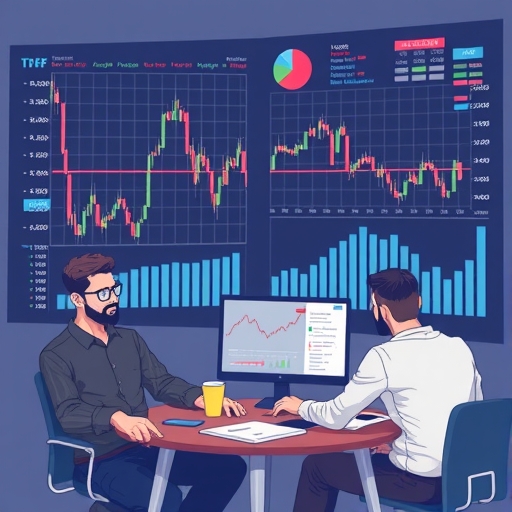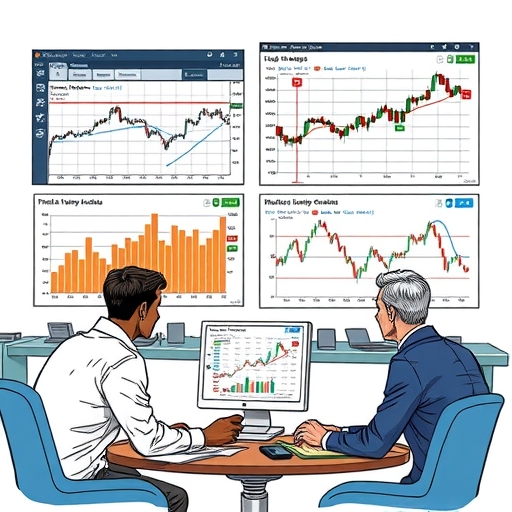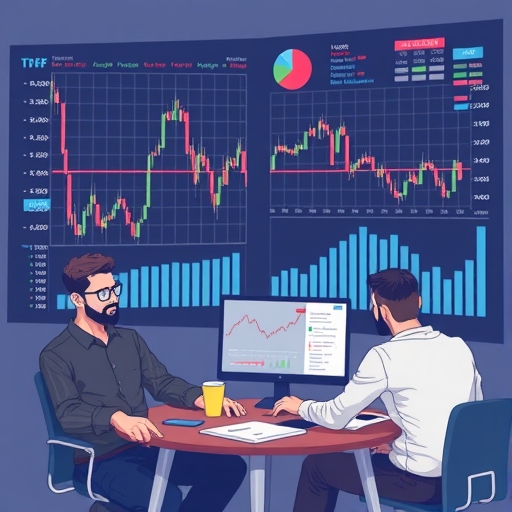“`html
Navigating the High-Octane World of Leveraged Equity ETFs: Understanding the Risks and Rewards
Welcome to a deep dive into a corner of the investment universe that has been generating considerable buzz and, frankly, some concern: leveraged equity exchange-traded funds (ETFs). We’ve observed a significant surge in interest and inflows into these products recently, and it’s crucial for you, whether you’re new to investing or a seasoned trader exploring technical analysis, to understand exactly what you’re getting into. These aren’t your average index funds, and the potential for amplified gains comes hand-in-hand with the potential for magnified losses.
In this article, we will explore the mechanics, the drivers behind their recent popularity, the inherent risks – especially the often-misunderstood phenomenon of performance decay – and why financial professionals urge caution. Our goal is to equip you with the knowledge needed to approach leveraged ETFs with eyes wide open, understanding that they are potent tools requiring careful handling.
Key Takeaways:
- Leveraged ETFs aim for amplified daily returns through derivatives.
- Daily rebalancing affects long-term performance and can result in performance decay.
- These funds are typically unsuitable for long-term investment strategies.
The Recent Surge: Why Investors Are Piling into Leveraged Equity Funds
Let’s start by acknowledging the undeniable trend. Recent data shows a remarkable influx of capital into leveraged equity funds. According to LSEG Lipper, these funds saw inflows totaling $10.95 billion this month alone, smashing the previous 5-year high of $9.2 billion recorded just last month. This isn’t a trickle; it’s a flood, signaling strong and growing investor interest.
What’s driving this surge? Part of it is tactical positioning. Following recent market selloffs – some of which were influenced by macro factors like U.S. trade tariffs imposed by figures like Donald Trump, and influenced by the anticipation surrounding potential Federal Reserve rate cuts – some investors are betting on a market recovery. They see leveraged ETFs as a way to potentially amplify their gains if the market rebounds sharply.
Think of it like wanting to catch a bigger wave. Instead of just riding the market’s movement, you’re looking for something that will move two or three times as fast in the direction you expect. This desire for amplified exposure during anticipated market swings is a key factor pulling investors towards these complex instruments.

Understanding the Core Mechanics: How Leveraged ETFs Aim for Amplified Daily Returns
So, how do leveraged ETFs work under the hood? Their fundamental promise is simple: to deliver a multiple of the *daily* performance of an underlying index or asset. For example, a 2X leveraged ETF on the S&P 500 (.SPX) aims to return 2% on a day when the S&P 500 rises 1%, and lose 2% on a day the S&P 500 falls 1%. Similarly, a 3X leveraged Nasdaq 100 (.IXIC) ETF like ProShares UltraPro QQQ (TQQQ) seeks to deliver three times the daily return of the Nasdaq 100.
The critical word here is “daily.” These funds are specifically designed to achieve their stated leverage target over a single trading day. They use a combination of financial engineering techniques, primarily derivatives and borrowing, to amplify exposure.
Imagine you have $100. A standard S&P 500 ETF might invest your $100 directly into S&P 500 stocks. A 2X leveraged S&P 500 ETF, however, might use your $100 as collateral and borrow another $100 (or use derivatives equivalent to $100 in exposure) to effectively have $200 exposed to the S&P 500’s daily movement. This leveraged exposure is reset at the end of each trading day.
| ETF Type | Leverage Ratio | Target Index |
|---|---|---|
| 2X Leveraged S&P 500 ETF | 2X | S&P 500 |
| 3X Leveraged Nasdaq ETF | 3X | Nasdaq 100 |
| 2X Leveraged Dow Jones ETF | 2X | Dow Jones |
Leverage and Derivatives: The Engine Behind Amplified Exposure
To achieve their leveraged daily targets, these ETFs don’t simply hold stocks proportional to the leverage. Instead, they primarily rely on sophisticated financial instruments, most notably derivatives. Derivatives are contracts whose value is derived from an underlying asset, index, or benchmark.
Common derivatives used by leveraged ETFs include:
-
Futures Contracts: Agreements to buy or sell an asset at a future date and price. Index futures (like S&P 500 futures) are frequently used to gain leveraged exposure to broad markets.
-
Swap Agreements: Contracts between two parties to exchange cash flows or returns from financial instruments. An ETF might enter into a swap agreement with a bank to receive a multiple of the daily return of an index in exchange for a fee.
-
Options: Contracts giving the holder the right, but not the obligation, to buy or sell an asset at a specific price by a certain date. While less common for core index leverage, options can be part of the strategy.
These derivatives allow the fund to achieve leveraged exposure efficiently without needing to physically hold large amounts of the underlying assets proportional to the leverage factor. They can, for instance, gain 3X exposure to the Nasdaq 100’s daily movement by holding a relatively small amount of cash and entering into swap or futures contracts that provide that amplified daily return profile. This is why you see funds like Direxion Daily Semiconductor Bull 3X Shares (SOXL) able to target 3X the daily return of a specific industry index.
The Daily Rebalancing Dynamic: Why “Daily” is Key and What it Means for You
Here is arguably the most crucial concept to grasp when considering leveraged ETFs, and it is often the source of investor misunderstanding: daily rebalancing. Because these funds are designed to achieve their stated leverage multiple over a single day, their holdings and derivative positions are adjusted at the end of each trading day to prepare for the next day’s target.
Why do they do this? If a 2X ETF started with $100 and $100 of borrowed money ($200 total exposure) and the index rose 10%, the fund’s assets would grow to $220. To maintain 2X leverage for the next day, it would need $220 in equity and $220 in borrowed money/derivatives, totaling $440 in exposure. It must rebalance to increase its exposure. Conversely, if the index fell 10%, the fund would be at $180. To maintain 2X leverage, it would need $180 in equity and $180 borrowed/derivatives, totaling $360 exposure. It must rebalance to decrease its exposure.
This daily reset mechanism has significant implications for performance over periods longer than one day. It’s not like investing $100 in a stock and just seeing it double or triple over weeks or months. The compounding effect of daily returns, especially in volatile markets, can lead to results that are significantly different from simply multiplying the underlying asset’s total return over that longer period by the leverage factor.

The Peril of Performance Decay: Volatility’s Hidden Cost
The consequence of daily rebalancing, particularly in markets that are volatile or trend sideways, is a phenomenon known as performance decay. This decay erodes returns over time and is perhaps the most significant risk for investors holding leveraged ETFs for more than a day.
Let’s use a simple example. Imagine an index starts at 100.
Day 1: Index goes up 10% (to 110). A 2X leveraged ETF starts at $100, goes up 20% (to $120).
Day 2: Index goes down 9.09% (back to 100). The ETF starts at $120, aims for 2X the daily move (-9.09% * 2 = -18.18%). The ETF ends the day at $120 * (1 – 0.1818) = $98.18.
After two days, the index is back where it started (100), a 0% return. But the 2X leveraged ETF, which started at $100, is now worth $98.18. It has lost value, despite the underlying asset returning to its starting point. This loss is performance decay.
Now imagine that volatility compounded over weeks or months. Even if the index trends upwards overall, periods of high volatility – where the index goes up one day, down the next, then up again – can cause the leveraged ETF’s performance to lag significantly behind 2X or 3X the index’s total return. As Jeffrey Ptak, Global Director of Manager Research at Morningstar, highlighted, these daily resets can “play havoc with returns” over longer periods.
This decay makes leveraged ETFs generally unsuitable for long-term holding or typical buy-and-hold investment strategies. They are designed as tactical tools for very short-term trading by knowledgeable investors who can actively monitor their positions.
Real-World Consequences: Magnified Losses in Action
The theoretical risk of performance decay and magnified losses becomes starkly real when we look at recent performance figures for specific leveraged funds, particularly the relatively newer leveraged single-stock ETFs. These products track the daily performance of just one company’s stock, amplifying both the potential gains and the specific risks associated with that single company.
For example, leveraged single-stock ETFs tracking high-profile, volatile companies have seen dramatic swings. Funds linked to MicroStrategy (MSTR) and Tesla (TSLA) have reportedly lost 80% to 83% of their value since their recent peaks. The estimated collective losses for investors in these specific funds are said to be around $1.7 billion. This figure is a sobering reminder of how quickly value can erode in these instruments when the underlying stock is volatile or moves against the leveraged position.
Consider the case of GraniteShares 2x Long NVDA Daily ETF (NVDL), tracking Nvidia (NVDA). Despite a period where NVDA experienced significant volatility and selloffs, NVDL reportedly received substantial inflows, including $1 billion during a single day when NVDA’s stock price fell. This suggests some investors might have been “dip-buying” the leveraged product, perhaps not fully appreciating that the performance decay risk is heightened during periods of volatility, regardless of whether the eventual trend is upwards.
These examples underscore that the magnified losses are not theoretical. They are a very real outcome of the mechanics combined with market volatility and directional risk over time. You can lose a significant portion, or even all, of your investment, potentially within a single day if the underlying asset experiences an extreme adverse movement.
The Rise of Single-Stock Leveraged ETFs: Added Risk and Concentration
The traditional leveraged ETFs tracked broad indices like the S&P 500 or Nasdaq 100. While still risky, these offer some level of diversification inherent in the index.
A more recent development in the market for complex ETFs is the emergence and growth of leveraged single-stock ETFs. These funds, like those offered by issuers such as Leverage Shares by Themes, target the daily performance of *individual* companies, like Boeing (BA), Nvidia (NVDA), or MicroStrategy (MSTR). We’ve seen new product launches, such as the Leverage Shares 2X Long BA Daily ETF (BOEG), expanding the range of options.
While they function similarly to index-based leveraged ETFs by seeking a multiple of *daily* returns using derivatives, single-stock versions introduce an additional layer of risk: concentration risk. With an index fund, even a leveraged one, the performance is spread across dozens or hundreds of companies. With a single-stock ETF, you are solely exposed to the daily volatility and specific risks of just one company.
This means that news, earnings reports, or even tweets specific to that one company can have a magnified impact on the leveraged ETF’s performance. If you are bullish on Boeing, for instance, buying a 2X leveraged BA ETF gives you amplified exposure to its daily stock movement, but also exposes you to 2X the risk of any single negative event affecting Boeing’s stock on a given day.

Their popularity, especially among retail investors, is fueled partly by ease of access via platforms like Robinhood and attention on social media. However, this ease of access may mask the inherent complexity and heightened risk profile compared to their index-based counterparts.
Who is Using These Funds? Retail Interest and the Role of Trading Platforms
While some sophisticated institutional traders might use leveraged ETFs for very short-term hedging or speculative strategies, a significant portion of the recent inflow appears to be coming from retail investors. These are often individual traders who are attracted by the promise of amplified gains and the ability to participate in leveraged trading without directly engaging in futures markets or using traditional margin accounts, which come with their own complexities like potential margin calls.
The accessibility offered by popular trading platforms has made it easier than ever for retail investors to buy and sell leveraged ETFs. This accessibility, combined with discussions and hype on social media channels, contributes to their popularity.
However, there is a widespread concern among financial professionals, including analysts at firms like Morningstar, that many retail investors purchasing these products may not fully grasp the nuances of daily rebalancing and performance decay. They might mistakenly believe that holding a 3X leveraged ETF for a year will result in 3X the total return of the underlying index over that year, which is generally not the case due to the compounding effect of daily returns and volatility.
As Jeffrey Ptak noted, these products are “complex.” They are “not designed for somebody who’s looking to buy and hold,” and are best suited for those who can “actively monitor” their positions. This suggests a potential mismatch between the intended user (short-term, knowledgeable trader) and a significant portion of the actual users (longer-term focused, less experienced retail investor).
Expert Warnings and the Importance of Due Diligence
It cannot be stressed enough: the financial industry, including fund issuers themselves, analysts, and regulators, consistently issues warnings about the high-risk nature of leveraged ETFs. The prospectuses for these funds often contain prominent disclaimers about their daily objective and the risks of holding them for longer periods.
Experts like those at Morningstar and Bloomberg have repeatedly cautioned investors. They emphasize that these are tactical trading tools, not investment vehicles for building long-term wealth. The potential for rapid and significant loss, including the loss of your entire principal investment, is real and can occur quickly, especially in volatile markets or if the underlying asset moves strongly against your position.
Imagine trying to hold a high-speed Formula 1 car steady on a bumpy dirt road. That’s a bit like holding a leveraged ETF in a volatile market. They are built for speed (amplified gains) in specific, short-term conditions, but they become unstable and can lose control quickly when the environment isn’t perfectly smooth.
Before you even consider investing in a leveraged ETF, it is absolutely essential that you:
-
Read the fund’s prospectus and understand its investment objective and risks.
-
Fully grasp the concept of daily rebalancing and performance decay.
-
Are comfortable with the possibility of losing a substantial amount, or all, of your investment.
-
Have a clear, short-term trading strategy and the ability to monitor your position actively.
Are Leveraged ETFs Right for You? Assessing Your Risk Tolerance and Trading Horizon
Given everything we’ve discussed – the amplified daily returns, the use of derivatives, the mechanics of daily rebalancing, and the significant risk of performance decay and magnified losses – how do you decide if a leveraged equity ETF fits into your trading approach?
First, honestly assess your risk tolerance. Are you comfortable with potentially losing a significant portion of your capital very quickly? If the thought of a large percentage drop in your portfolio value in a single day causes you stress, leveraged ETFs are likely too aggressive for you.
Second, consider your trading horizon. Are you looking for positions you might hold for hours, or perhaps a day or two at most, in anticipation of a very specific, short-term market move? Or are you someone who prefers to hold investments for weeks, months, or even years? If your horizon is anything other than very short-term, the risks associated with daily rebalancing and decay make these funds generally inappropriate.
Leveraged ETFs are best suited for sophisticated traders who use them tactically for specific purposes, such as hedging an existing portfolio for a very short period, or making a high-conviction, short-term directional bet on an index or stock movement. Even then, professional traders understand the risks intimately and manage their positions actively.
For most investors, particularly those focusing on long-term wealth building, the standard, unleveraged versions of equity ETFs offer broad market exposure without the complex risks and performance decay issues inherent in their leveraged counterparts.
Beyond Leveraged Equity ETFs: Understanding the Broader Landscape of Complex ETPs
Leveraged equity ETFs are part of a broader category of complex exchange-traded products (ETPs) that have grown significantly in recent years. This landscape includes inverse ETFs (which aim to profit from market declines), inverse leveraged ETFs (combining leverage and inverse exposure), single-stock ETFs (leveraged and unleveraged), and other products using derivatives to achieve specific outcomes, such as defined outcome ETFs.
The growth in assets within leveraged ETFs – totaling $134 billion at the end of January, a 51% increase year-over-year – highlights the increasing investor appetite for these more complex strategies. Leveraged and inverse products now represent a notable segment of the derivatives-based equity ETP market, with leveraged single-stock products accounting for about 9% of this segment.
This expansion means you encounter more varied and potentially complex ETPs when exploring trading options. While this offers flexibility for sophisticated strategies, it also underscores the need for heightened due diligence before investing in any product that uses leverage or derivatives extensively and is not a simple long-term holding vehicle.
Always remember that the ease of trading complex products on platforms doesn’t change their underlying nature or risks. Understanding the mechanics behind any ETP you consider is paramount.
Conclusion: Navigating the High-Stakes World of Leveraged Equity ETFs
Leveraged equity ETFs have captured the attention of many investors, driven by their promise of amplified returns during market swings and their increasing accessibility. We’ve seen billions flow into these funds as investors position for potential market recoveries, partly influenced by macroeconomic factors like trade tariffs and Federal Reserve policy expectations.
However, as we’ve explored, these products are not simple investments. Their design to achieve leveraged returns on a *daily* basis through derivatives and rebalancing creates significant risks, most notably performance decay over periods longer than a day, especially in volatile markets. The real-world examples of steep losses in specific leveraged single-stock ETFs serve as a powerful reminder of this reality.
Leveraged ETFs are powerful, high-risk tools intended for experienced traders with a very short-term horizon who can actively monitor their positions. They are generally unsuitable for long-term investors or those who are not comfortable with the potential for rapid and severe losses.
Before you allocate capital to these products, take the time to fully understand their mechanics, the compounding effects of daily returns and volatility, and the specific risks associated with the underlying asset. Armed with this knowledge, you can make informed decisions and determine if leveraged ETFs align with your trading goals, risk tolerance, and ability to manage potentially volatile positions.
leveraged equitiesFAQ
Q:What is a leveraged equity ETF?
A:A leveraged equity ETF is a fund designed to achieve amplified daily returns by using financial derivatives and borrowing to enhance exposure to an underlying index or asset.
Q:What are the risks associated with leveraged ETFs?
A:Risks include performance decay, magnified losses, and significant volatility, making them unsuitable for long-term holding strategies.
Q:Who should consider investing in leveraged ETFs?
A:They are best suited for experienced traders looking for short-term opportunities and who can actively monitor their investments.
“`

留言